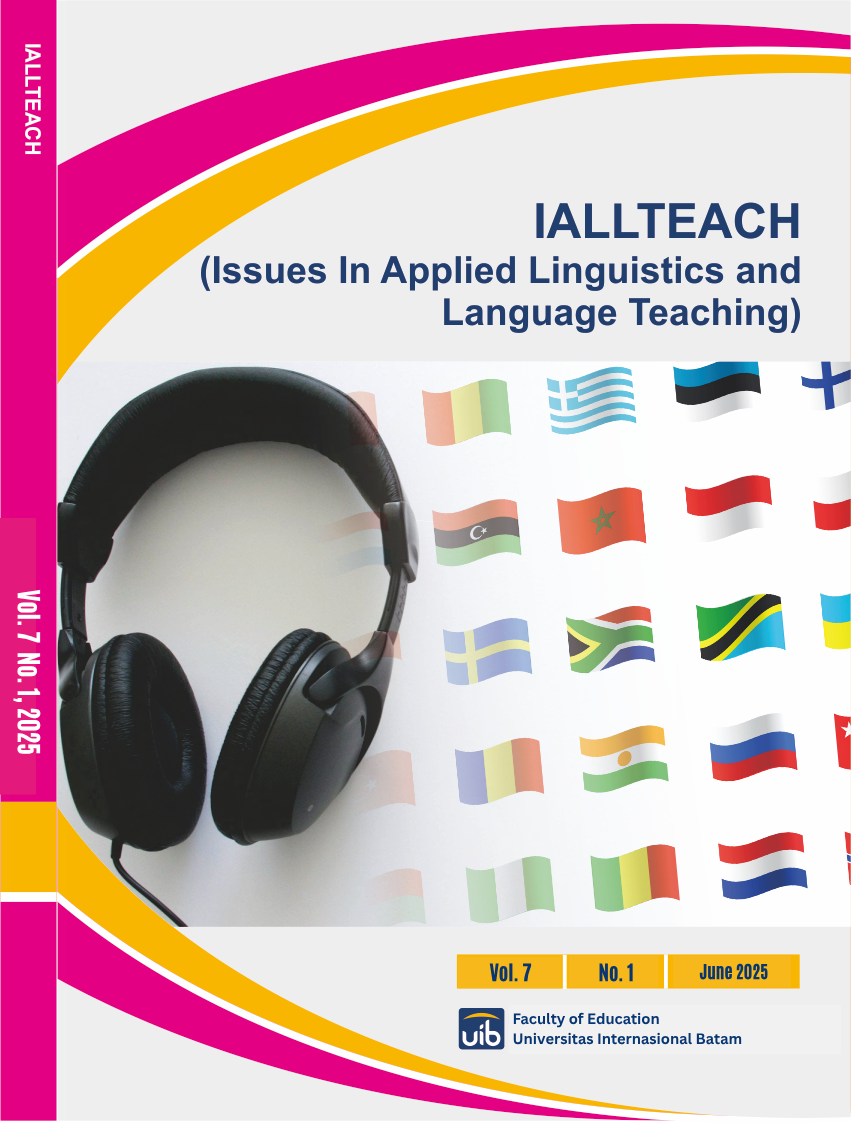Maximizing ELSA Speak for Developing English Fluency and Reducing Speaking Barriers in Language Learners
DOI:
https://doi.org/10.37253/iallteach.v7i1.10421Keywords:
ELSA Speak, English Fluency, Speaking Barriers, Pronunciation, Digital LearningAbstract
Many language learners face challenges in developing English speaking fluency, including mispronunciation, limited vocabulary, and low self-confidence. This study examines the effectiveness of the ELSA Speak application in improving speaking skills and reducing speaking barriers. Using an Explanatory Sequential Design, the research includes a quantitative phase followed by a qualitative phase. In the quantitative phase, students took pre-tests and post-tests to measure progress. Results showed significant improvement, especially in pronunciation. The qualitative phase involved interviews to explore students’ experiences using the app. Findings revealed increased confidence, reduced anxiety, and positive responses to the app’s real-time feedback and pronunciation correction features. Despite minor technical issues, students found ELSA Speak engaging and helpful for independent practice. The study concludes that ELSA Speak is an effective tool for enhancing fluency and addressing speaking difficulties. These results suggest that digital applications can support traditional language learning by providing structured and interactive speaking practice.
Downloads
References
Csizér, K. (2019). The L2 Motivational Self System BT - The Palgrave Handbook of Motivation for Language Learning (M. Lamb, K. Csizér, A. Henry, & S. Ryan (eds.); pp. 71–93). Springer International Publishing. https://doi.org/10.1007/978-3-030-28380-3_4
Huda, F., & Rahmawati, H. (2024). The Effectiveness of ELSA Speak Role Playing to Teach Speaking on Report Texts. 8(2), 136–145. https://doi.org/10.28926/jdr.v8i2.406
Kampira, A. (2021). A Brief Introduction to Thematic Analysis. ACM SIGPLAN Notices, 28(3), 359–360. http://dx.doi.org/10.13140/RG.2.2.25899.57128
Kim, H., & Kim, J. (2021). The role of output in second language speaking fluency development: A meta-analysis. Language Teaching Research, 22(5), 664–682. http://dx.doi.org/10.1177/1362168816679030
Kumar Betal, A. (2023). Enhancing Second Language Acquisition through Artificial Intelligence (AI): Current Insights and Future Directions. Journal for Research Scholars and Professionals of English Language Teaching, 7(39). https://doi.org/10.54850/jrspelt.7.39.003
Lee, J. (2021). Digital feedback for second language pronunciation learning: A review. Language Learning & Technology, 25(3), 1–20. https://scholarspace.manoa.hawaii.edu/bitstreams/de45495d-805c-4608-b095-9b20305323aa/download
Lee, J., & Lee, K. (2020). The role of metacognitive feedback in mobile-assisted pronunciation training. ReCALL, 32(3), 308–326. http://dx.doi.org/10.30191/ETS.202304_26(2).0003
Lin, C.-H., & Lan, Y.-J. (2020). Language learning in the era of AI: Opportunities and challenges. 23(4), 45–59. Journal of Educational Technology & Society, 23(4), 45–59. http://dx.doi.org/10.1515/jccall-2023-0015
Muhsin, M. A. (2016). Teknik Penilaian Dalam Pembelajaran, Matriks, dan Vektor. June. Online. https://www. researchgate. net/profile/Muh_Arief_Muh sin/publication/304437379_TEKNIK_PENILAIAN_ DALAM_PEMBELAJARAN_BAHASA/links/576f6 0a408ae62194746bfe9/TEKNIK-PENILAIANDALAM-PEMBELAJARAN-BAHASA. pdf
Park, M., & Son, J. (2023). Mobile apps in language learning: Enhancing learner autonomy and motivation. Educational Technology Research and Development, 71, 123–140. http://dx.doi.org/10.4018/978-1-4666-6343-5.ch012
Samuels, P. (2011). Community Project Overview. Statstutor, 2–5. http://openvpn.net/index.php/open-source/245-community-open-source-software-overview.html
Viberg, O., & Grönlund, Å. (2012). Mobile assisted language learning: A literature review. CEUR Workshop Proceedings, 955(May), 9–16. https://ceur-ws.org/Vol-955/papers/paper_8.pdf
Xodabande, I. (2017). The effectiveness of social media network telegram in teaching English language pronunciation to Iranian EFL learners. Cogent Education, 4(1), 1347081. https://doi.org/10.1080/2331186X.2017.1347081
Zhang, R., & Zou, D. (2022). Types, purposes, and effectiveness of state-of-the-art technologies for second and foreign language learning. Computer Assisted Language Learning, 35(4), 696–742. https://doi.org/10.1080/09588221.2020.1744666
Zhang, Y., & Xu, L. (2022). The impact of technology-mediated feedback on reducing speaking anxiety. Modern Language Journal, 106(2), 345–360. http://dx.doi.org/10.1080/09588221.2022.2055083
Zou, D., Li, P., & Li, B. (2022). The effectiveness of AI-driven mobile applications in improving language proficiency: A meta-analysis. Educational Technology Research and Development, 70(2), 521–543. http://dx.doi.org/10.1080/09588221.2018.1501069




.png)






